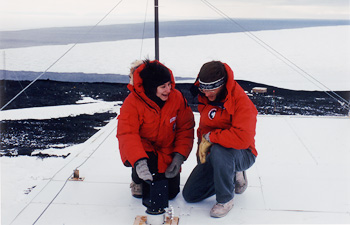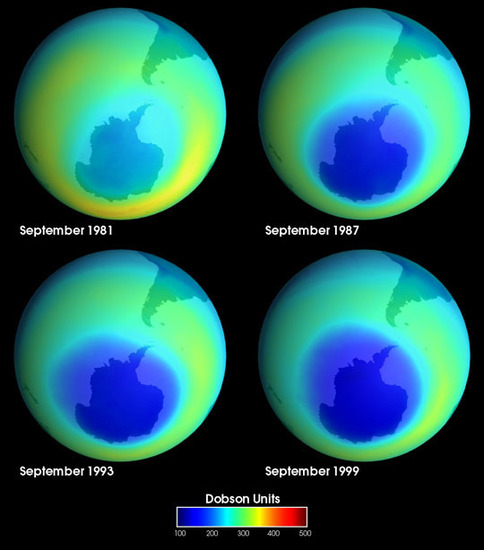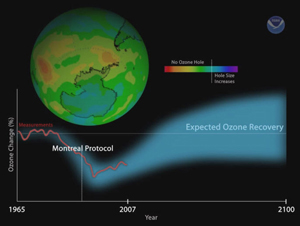PAOC Spotlights
Susan Solomon on Lessons from the Ozone Hole
MIT Atmospheric Chemist Susan Solomon recounts how scientists, world governments, and the public worked together to stop the ozone hole from growing, and what we can learn from those actions that could be applied to the climate change problem.
***

Last week, MIT Professor Susan Solomon delivered the 2015 Sears Public Lecture at Woods Hole Oceanographic Institution. Solomon, an atmospheric chemist and climate scientist, is renowned for her pioneering research that established the cause of the ozone hole above Antarctica. During her talk titled “Ozone Depletion: A Science and Policy Success Story,” Solomon recounted her and colleagues’ efforts to document the hole soon after its discovery as well as the ensuing policy changes that saved Earth from the brink of disaster.
Ozone—a gaseous molecule that blankets the Earth—absorbs harmful ultraviolet light, protecting humanity from high rates of skin cancer, eye disease, and other UV induced illnesses. In the 1970s, scientists found the amount of ozone in the stratosphere over Antarctica was severely depleted. Solomon and colleagues journeyed to frozen continent, where they conducted observational experiments that established chlorofluorocarbons (CFC)—a synthetic organic compound used in air conditioning units, aerosol spray propellants, and in the cleaning processes of delicate electronic equipment—as a major cause of ozone depletion.

Chlorine molecules in CFCs are separated from the compound by UV radiation and attack ozone molecules, turning them into oxygen in a catalytic cycle that lasts decades. A single chlorine molecule can destroy 100,000 ozone molecules and persist in the stratosphere for 50 to 100 years before decaying. In the mid-1980s, scientists hypothesized that stratospheric ozone would decrease 3 to 5 percent by 2100 if humans continued using CFCs at then-current rates, Solomon said. But her team discovered that CFCs combined with polar-stratospheric clouds, which reflect UV light, greatly increased the rate of depletion. Left unchecked, ozone depletion would begin to occur on a global scale.
Increased media and governmental attention surrounding this discovery led the public to make simple lifestyle changes—such as using roll-on deodorant instead of sprays—to help the environment even before governments took action, which they finally did in 1987. That year, the United Nations created the Montreal Protocol, which phased out CFC emissions. “It was just like the Kyoto Protocol, except it actually worked,” Solomon said. By 1999, every nation agreed to phase out emissions of the harmful chemical.
Solomon noted that the United States along with allies Sweden, Norway, Canada, and Japan, were the strongest backers of the protocol—contrary to popular perceptions of the U.S. as largely loyal to industry and skeptical of environmental science. "People find it difficult to imagine the U.S. being a global leader on a U.N. environmental treaty, because it's been a while since that happened," Solomon said. "But it's not impossible." The combination of science and consumer sentiment motivated the U.S. to lead the initial push to phase out CFCs. "In the end, I like to say it took a village," she said. "The science mattered, it was powerful and everyone could understand it, and the issue was personal and perceptible."
 Thanks to the effects of the Montreal Protocol and more environmentally-friendly alternatives, a CFC emission backslide is unlikely. "The atmosphere is already starting to heal, which is pretty cool,” she said. “We did that." Solomon noted that the next environmental hurdle is climate change. She chaired the Intergovernmental Panel on Climate Change from 2002 to 2007 and was formerly the head of the Chemistry and Climate Processes Group of the National Oceanic and Atmospheric Administration based in Boulder. Although climate change is a much more complicated issue, the public can learn a thing or two from how the ozone hole was handled, she said.
Thanks to the effects of the Montreal Protocol and more environmentally-friendly alternatives, a CFC emission backslide is unlikely. "The atmosphere is already starting to heal, which is pretty cool,” she said. “We did that." Solomon noted that the next environmental hurdle is climate change. She chaired the Intergovernmental Panel on Climate Change from 2002 to 2007 and was formerly the head of the Chemistry and Climate Processes Group of the National Oceanic and Atmospheric Administration based in Boulder. Although climate change is a much more complicated issue, the public can learn a thing or two from how the ozone hole was handled, she said.
“From the scientific point of view, the fingerprints [of climate change] are emerging and they will become clearer over time, but they’re much more difficult to explain to people,” she said. “They’re not as obvious as the ozone issue was.” Solomon emphasized that climate change is an infinitely more complex problem with multiple moving parts—including energy supply infrastructure and the world economy—that make the singular solution approach used for CFCs impossible. And climate change doesn’t pose immediate threats to humanity that the ozone hole did, such as skin cancer and other serious illnesses, to galvanize the public into action.
Although ozone depletion and climate change are different problems, the approach to fixing one could be uniquely adapted for the other. Solomon suggested multiple solutions, including institutional revamping of the energy system, investment in innovation and engineering, a top down emissions policy as well as a bottom up technology policy, and public engagement. “The most important thing is not to take the bus, but write to your congressman,” she said. “The most important thing is to engage with the policy process in a way that will help build a public consensus, which was done with the ozone issue. Without a public consensus we won’t have a policy change.”
During the question and answer session at the end of the talk, an audience member asked Solomon how the millennial generation can make significant change in the face of cynicism and feelings of helplessness. Although Solomon didn’t have a specific answer, she advised finding ways to get involved that work best for this generation and warned of the consequences of inaction. “If you don’t engage, you’ll inherit a planet that’s extremely hot,” she said. “By the end of 2100, if it’s business as usual, Earth is going to become a different place and a lot more uncomfortable place for a lot of people.”
This article was made possible by the National Science Foundation FESD project.